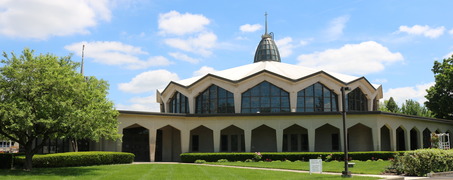Christ the King Parish was canonically established on January 17, 1946 by the Most Reverend Michael J Ready, Bishop of the Catholic Diocese of Columbus.
Following World War II, much of the surrounding area was about to be platted into city lots for real estate development. To the south of the church’s Livingston Avenue property, was Berwick Golf Course where, in the early forties, a buddy and I, with our dads’ golf clubs, ventured forth on a few early Saturday mornings to try our skill at the game.
The first parish mass took place February 3, 1946 with 150 families taking part under their new pastor, Reverend Leo R Brehm.1 At first, the congregation met for worship at the Elementary School at Main and Montrose. They carried on their social and business meetings at the Jeffrey Mansion, while Father Brehm conducted church business from his rental apartment at the corner of Berwick Boulevard and South Cassingham Road.
Within a year, they had positioned two army barracks, joined together – this became their “spiritual home” for nearly 20 years. In the fall of 1947, Christ the King Elementary School opened in two classrooms behind the sanctuary area. The 56 parish children attending were taught by two Dominican Sisters of the St. Mary of the Springs community.
The parish grew rapidly with the expanding residential population – which consumed the golf course. A conference of St. Vincent de Paul Society was formed to provide food and other items to those in need. A women’s club organized the religious and social activities, which expanded the outreach of the new parish – including support and leadership to the newly formed Columbus Diocesan Council of Catholic Women. A boosters’ club gave parental support and financial backing to the school’s competitive athletic agenda.
With the new school building completed in 1951, the parishioners had meeting rooms for their organizations, a place for athletic programs, and a location for their lawn-fetes and festivals – which, along with being fun-filled community events, provided a means of fund-raising toward a permanent church building. Mrs. Jean A Gloeckner, a long-time member, fondly remembers these gatherings that revealed the spirit and commitment of time and effort toward the establishment of their parish.2
A much-needed rectory for the pastor and his associate pastors was built in 1954. A convent for the Dominican Sisters was completed in 1957 and, in 1960, the school building was about to double in size.

Upon the unexpected death of Father Brehm in September, Monsignor Francis J Schwendeman was appointed on October 20, 1964. It is at this time that the task of constructing the permanent church building was undertaken. The school auditorium served for worship until the dedication of the new church on Sunday, April 21, 1968. As mentioned in the booklet commemorating Christ the King’s 50th Anniversary, the new church was “completely finished to conform with liturgical changes in the Catholic Church brought about by Vatican II.”
Rev. Monsignor James P Hanley, having replaced Rev. Monsignor Schwendeman in 1969, presided over the formation of a Parish Council. The council was elected, at large, by the people of the parish and served as a means for communicating the needs and ideas of parish members and their various organizations.
A pre-school program was begun in 1983 by the succeeding pastor, Rev. Monsignor Michael L Donovan. The Children’s Center ministers to working parents of children aged 2 to 5. Along with this, a before-and-after school care program was started for those enrolled in Christ the King School.
High on the list of spiritual endeavors for the parish of Rev. Monsignor Edward F Trenor, appoint pastor in 1990, was RENEW. This was “a three-year national program designed to increase individual and parish spirituality through prayer/study groups, meeting in homes to pray together and study the scriptures.”
With many younger families settling further out in the suburbs, the parish of Christ the King has stabilized at about 1,400 families. Father Trenor, in my interview, pointed out that the elementary school continues at about 500 students, serving the current diverse neighborhood, including some non-Catholics. Last year, a Spanish-language mass was begun on Sunday afternoons. Certainly, Christ the King Parish continues to serve its changing community.3
Adapted from article By Edward L. Hamblin
Bexley Historical Society President, 1997-2002
Originally published in Historical Herald, December 2002
If you have information to add to this topic, please let us know.
All comments are reviewed before posting.
1 Much of this article is taken from the booklet, 50th Anniversary Christ the King Church 1946-1996, edited by Martha Sliter Sheeran.
2 Telephone interview of Ed Hamblin with Mrs. Jean A Gloeckner, October 8, 2002.
3 Personal interview of Ed Hamblin with Monsignor Edward F Trenor, October 1, 2002.
